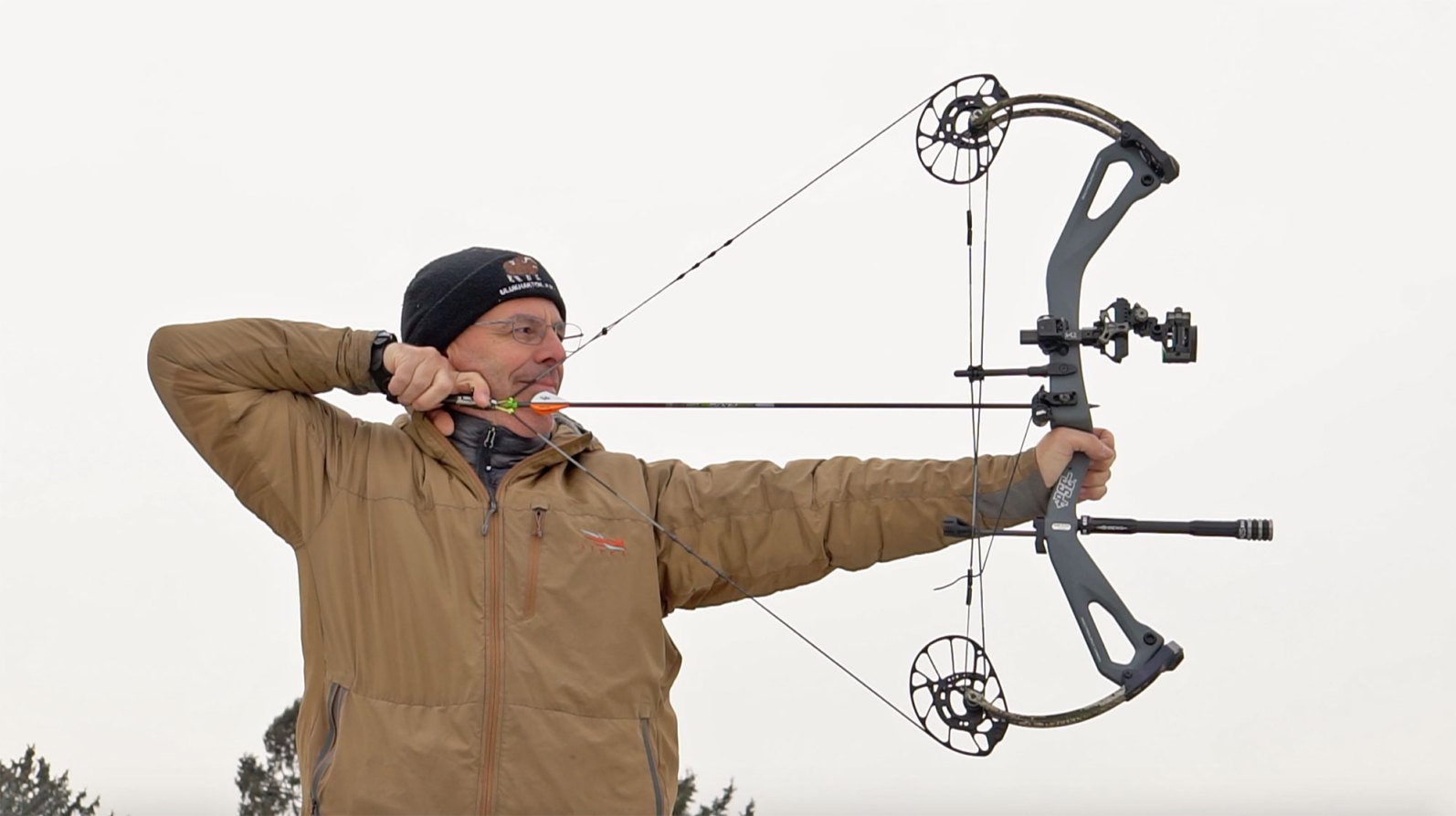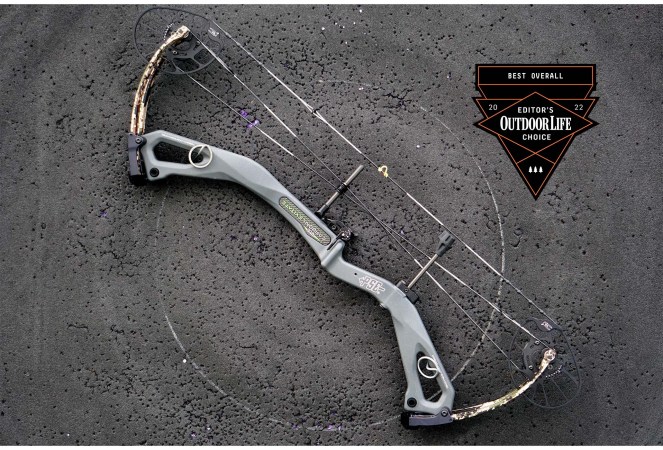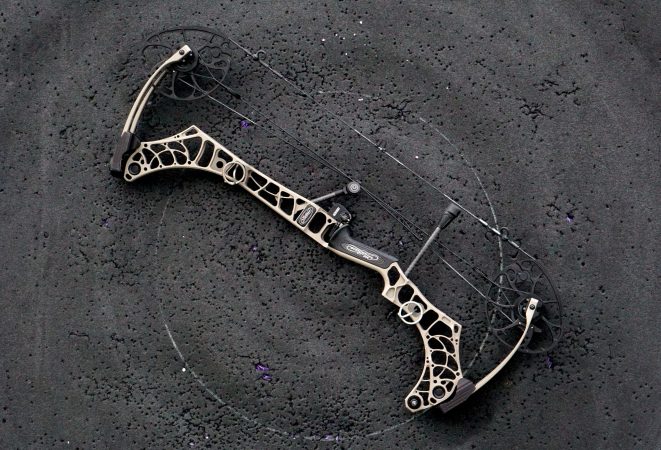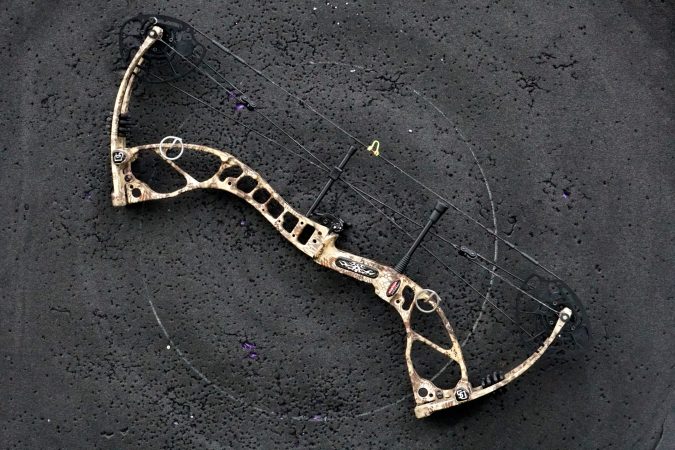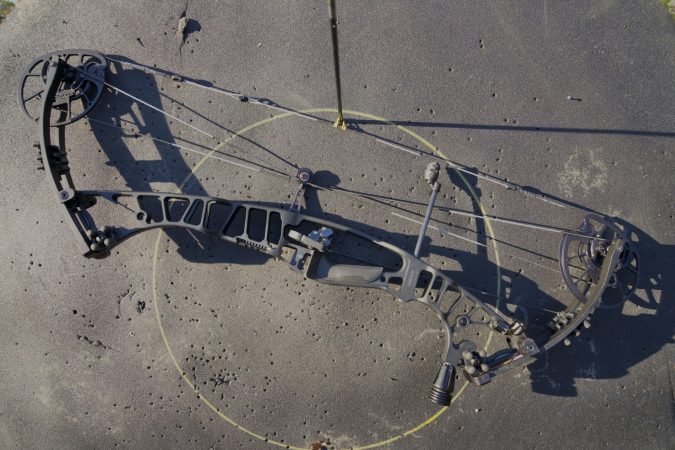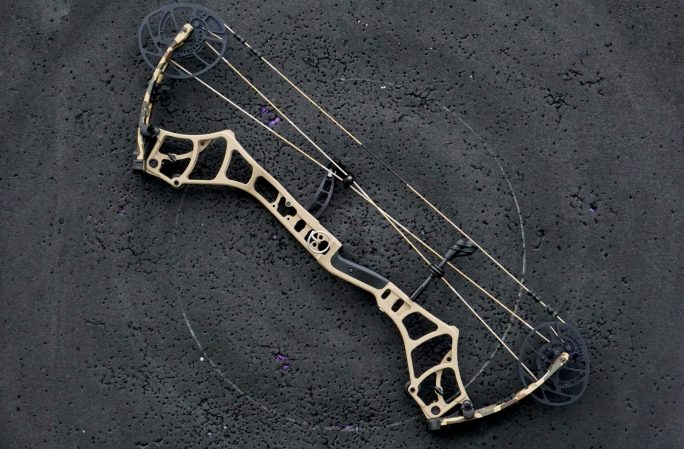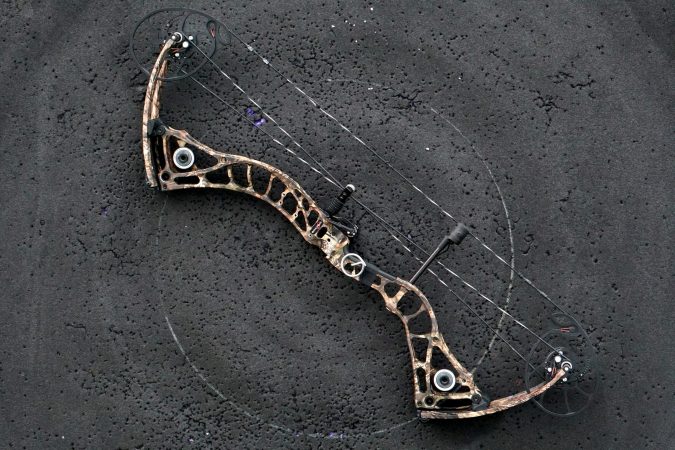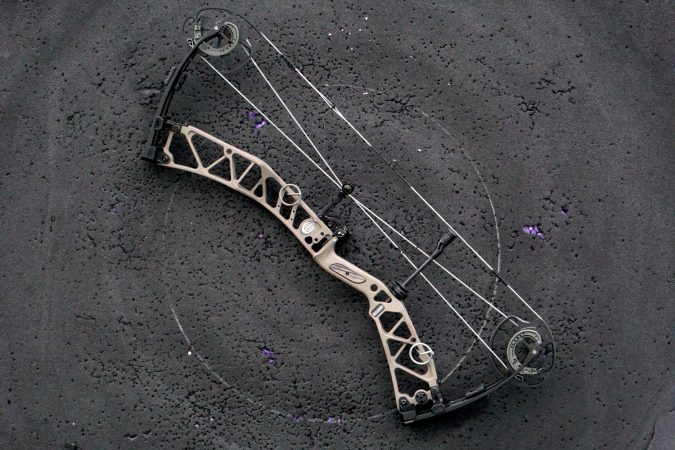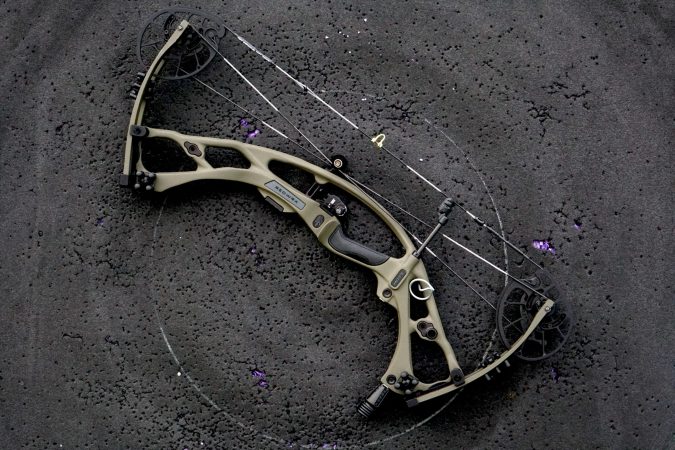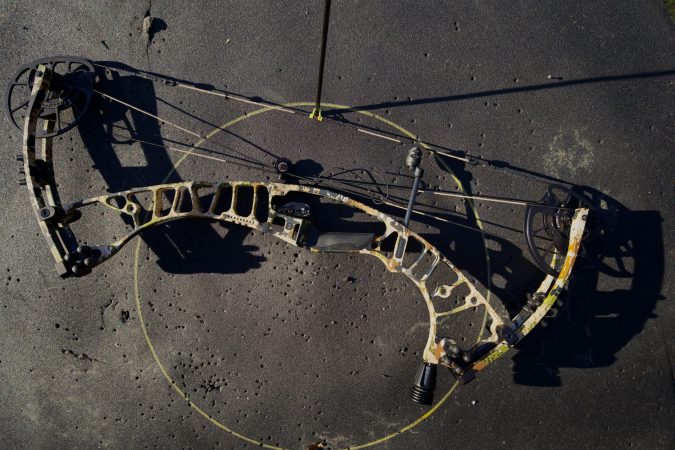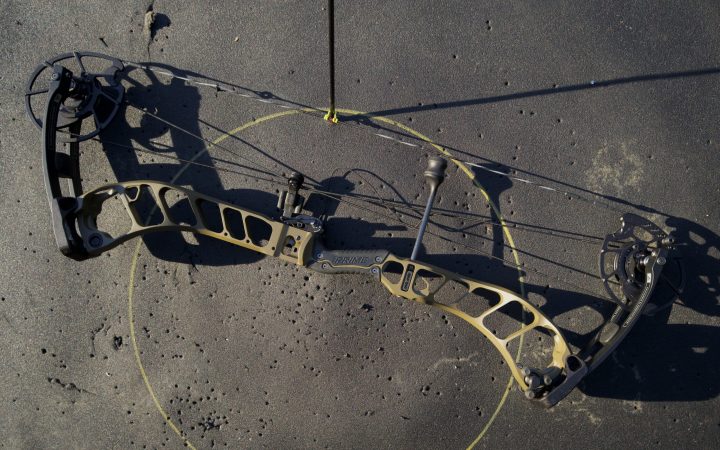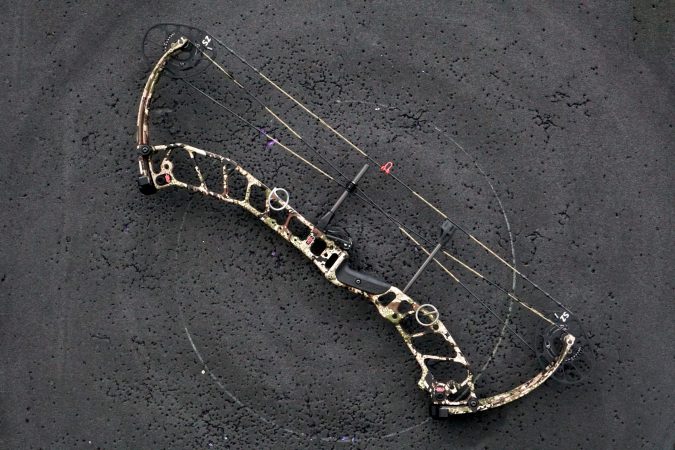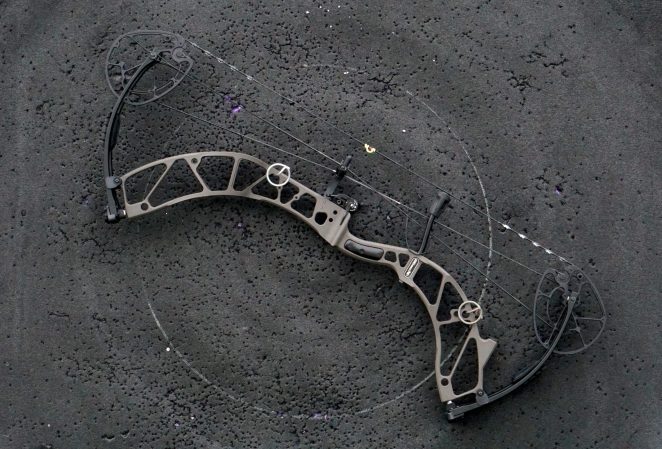We may earn revenue from the products available on this page and participate in affiliate programs. Learn More ›
How do you pick a compound bow when every top manufacturer makes an excellent flagship? Simple. You round up the field of new bows, send them to Lancaster Archery Supply, the country’s premier archery shop, and then tune, chronograph, and shoot the hell out of them until only one bow is left standing. And that’s exactly what we did for the 2022 Outdoor Life Bow Test.
It wasn’t easy picking a winner. You might have heard people say, “There are no bad bows these days,” and it’s a mostly true statement. But each bow has design characteristics that will make it ideal for different bowhunting scenarios and shooting styles.
So don’t buy a bow based on what your favorite celebrity bowhunter shoots or what your buddy says is the best. Buying a bow in 2023 is all about finding the bow that’s best for you.
In this review you’ll find far more information than manufacturer’s specs and basic YouTube video reviews can provide. You’ll find accurate speeds shot with an actual hunting-weight arrow, tuning information, accuracy data, and details on the bow’s shooting characteristics. That information will help you narrow down the field to a handful you can test at an archery shop.
- Editor’s Choice: PSE Nock On Carbon Levitate
- The Best Shooting Experience: Mathews V3X
- The Sleeper: Darton Spectra E
- Best Long-Draw Bow: Hoyt Highline
2023 Compound Bows
The 2023 bow test will publish in early March 2023, but until then, we have reviews on some of the best new bows for 2023.
Mathews Phase 4
The Mathews Phase 4 looks a lot like the 2022 V3X, which we thought had the best shooting experience of any of the bows we tested. But, it utilizes a brand new limb design that cuts vibration and quiets the bow even more. Read our full Phase 4 review to learn more.
Prime Revex
Prime’s 2023 flagship uses a brand new cam design that emphasizes shooting experience over adjustability. It has a fixed draw-length module instead of the common rotating module, which makes the bow optimized for the entire draw length range. It also comes in three axle-to-axle lengths to fit just about any archer’s preference. You can read our full Prime Revex review to learn more.
Elite Omnia
Elite is known for smooth drawing and soft shooting bows. But, their latest flagship hunting bow has Elite’s renowned “shootability,” but with more speed than before. The bow we tested shot a 475 grain arrow at 302 fps (70 pounds, 29-inch draw length). Read our full Elite Omnia review for more info.
Elite Era
For the first time ever Elite has a carbon riser, and their first attempt is fantastic. Check out our full review of the 2023 Elite Era for more info.
How We Tested the Bows





Specs
To get a baseline, we weighed the bows with just the QAD arrow rest mounted as well as measured their exact draw weight and draw length. The exact draw weight is to provide context for the bow’s speed. All bows were set two turns out from their 70 pound max for 65 pounds +/- 2 pounds. We also measured the holding weight, so you know how much weight you’re holding at full draw with each bow.
Measuring a bow’s exact draw length on a draw board provides context for speed and tests if the bow is hitting its specified draw length. We set bows at 29 inches of draw length and measured the draw length using the ATA standard of the string apex to the pivot point plus 1.75 inches.
Tuning
Next we timed the cams, set the center shot to the standard 13/16 inch, and set the nocking point height level. Then we did a basic paper tune, during which we judged the bows on how easy it was to get a bullet hole. With tuning complete, we recorded the final center shot and nocking point height to give you a starting point for your own tuning.
The 5-Foot Test
When you try out a bow at an archery shop you’ll likely test it close to the target and judge the bow on its feel. While shooting a bow for accuracy is an important component of this test, we also tested a bow’s grip, back wall, perceived vibration, and draw cycle at close range so we could focus on those attributes without worrying about shooting tiny groups. Testers rated each feature and provided notes on them.
Accuracy Testing
Accuracy testing started at 20 yards. Each tester shot five, three-shot groups at a 40 cm target face and measured their groups with calipers. The accuracy testing then moved to 50 yards with five, three-shot groups. At 50 yards, bows were also equipped with a Mantis device to capture data on holding patterns.
Mantis X8
The Mantis X8 is a small sensor that attaches to a bow’s riser and sends data to the Mantis app. In addition to showing pin movement, it shows how much the bow moves from the time of release to the arrow leaving the bow. It’s a valuable tool for archers who want to improve their form or dial in their setup. It also helped us collect objective data on how steady each of the bows shot without stabilizers. While the testers could tell for themselves if a bow held steady or wobbled like a chicken on tightrope, the Mantis X8 allows us to actually show you what a bow’s float pattern looks like.
We included Mantis data in the reviews for bows that held exceptionally steady and for bows that were more difficult to shoot. The orange line shows a bow’s movement while at full draw, and the red line shows a bow’s movement after release. There are two Xs: one for the bow’s position when the arrow was released and one for the bow’s position when the arrow left the bow. The Mantis also provides a stability score on a 100 point scale. A poor shot will be in the 70s, an average shot will be in the mid-80s, and our best shots were in the mid-90s.
Speed
We shot Easton Axis 5mm shafts in a 300 spine cut to 28.75 inches with a 100-grain field point, which overall weighed 450 grains. Bows were shot at the exact specs listed for each bow—approximately 65 pounds and a 29-inch draw length. We used a Labradar doppler chronograph to measure five shots from each bow. We then averaged those five recorded speeds for the final spec. Because everything from a bow’s tune to the weight of the peep can affect a bow’s speed, the speeds listed below are meant to provide reference points, not the final word on a bow’s speed.
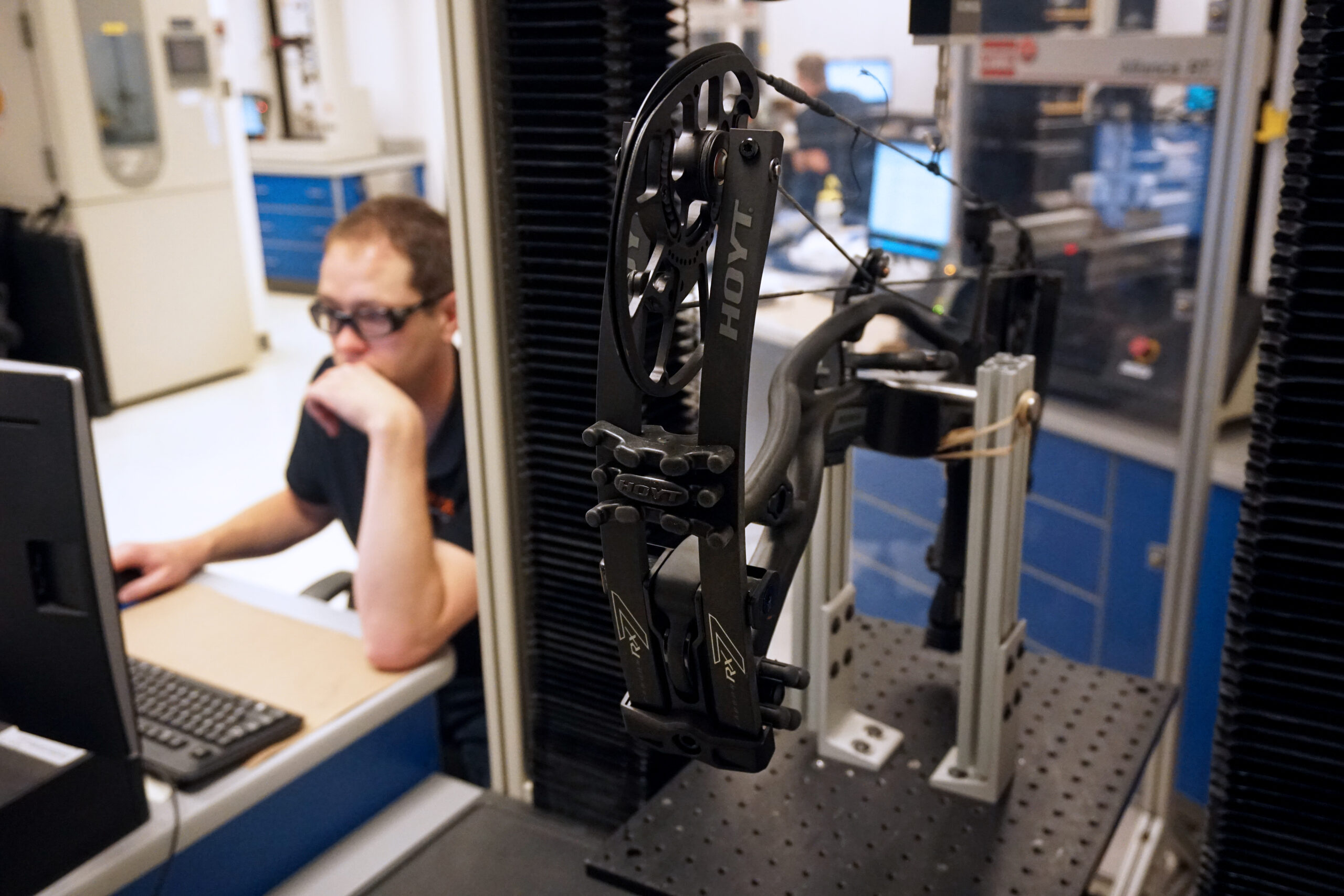
Stress Engineering
For objective testing, we partnered with Stress Engineering Services to test several of the best bows in their lab in Mason, Ohio. Testing at their lab includes precise noise, vibration, and efficiency measurements. The engineers in their Outdoor Division are able to test for acceleration impulse(vibration), efficiency, and sound using advanced sensors and meters. You’ll see this data in the bow reviews when relevant, but we did not use it to determine our award because not all bows were tested at Stress Engineering.
Forgiveness
Good bows hit right behind the pin. Really good bows hit the middle even when you’re not shooting great; a bow that can do that is called forgiving. At the end of testing there were two bows at the top of the heap. To test them further, we conducted a forgiveness test that simulates three common mistakes archers make when under pressure: creeping, torquing the grip, and pulling hard into the stops. The tester intentionally made each of those mistakes to see if the point of impact changed.
Gear We Used
Chronograph: Labradar
The Labradar uses doppler radar to track a projectile and measure its speed. We chose it over a traditional chronograph because it provides consistent reading no matter the lighting conditions.
Bow Sight: Garmin Xero A1i Pro
I reviewed the Garmin Xero A1i Pro this fall, and liked the precise aiming dot it provides as well as the fast sight-in process.
Arrows: Easton Axis 5mm
The Easton Axis 5mm is one of my favorite hunting shafts. I chose it for the test because it’s a consistent shaft that would give us an arrow weight in the mid 400s.
Arrow Rest: QAD Ultrarest
I wanted an arrow rest that would be easy to set up without hindering our accuracy. The QAD was a perfect fit.
Other Tools Used
The Test Team
P.J. Reilly: Longtime bow reviewer and video host for Lancaster Archery Supply. Reilly is also an accomplished archer who has bowhunted everything from whitetails to musk ox.
Alex Robinson: Outdoor Life’s Editor-in-Chief, bow test veteran, and workaday bowhunter.
Scott Einsmann: Outdoor Life Executive Gear Editor, former archery coach, and lifelong archery nerd.
Best Overall Compound Bow, Editor’s Choice: PSE Nock On Carbon Levitate
Specs
- Axle-to-axle: 32.5 inches
- Weight: 3.80 pounds
- Speed: 282.2 fps
- Draw length: 29 inches
- Draw weight: 64.3 pounds
- Holding weight: 8.8 pounds
- Center shot: 13/16 inch
- Nocking point: Level
- MSRP: $1,899
PSE Carbon Levitate Review

The PSE Carbon Levitate annihilates preconceived notions about carbon bows. We could not believe how a bow that’s so crazy light could shoot such tight groups, have little vibration, and just be an all around pleasure to shoot.
The secret sauce that went into the Levitate was concocted by John Dudley and PSE engineers, who set out to solve many of the issues with carbon bows, starting with the riser. Each Levitate carbon riser is hand laid in the U.S.A. using proprietary Dead Frequency carbon. The carbon material is designed for rigidity and to reduce feedback. The levitate also sports PSE’s new E2 cam, an evolution of the popular Evolve cam. But, we liked the subtle upgrades like the wider cams, ¼-inch axle, and the beefier bearings used on the Levitate. Those upgrades give the bow longevity and accuracy. The limbs are also split wider apart, which makes the bow more torsionally stable. Another smart feature on the Levitate is the cable guard, which is screwed and pinned into the riser. That means you’ll never have to worry about a cable guard coming loose during a hunt and throwing off your tune.
Testing the Carbon Levitate
We started each test with a paper tune and tuning the Levitate was drama free. The first shot was a bullet hole and it didn’t need additional adjustments. One tip for tuning the Levitate is that if you’re getting a wicked lateral tear through paper, try a stiffer spine before you pop off the e-clips and start shimming.
There was one resounding theme in the accuracy testing: The PSE Levitate shoots better than it should. Lightweight bows are supposed to be difficult to shoot, but the testers found this bow to be extremely accurate. Reilly’s 50-yard groups averaged 2.8 inches and Robinson averaged 2.75 inches. Robinson even shot a Robinhood at 50 yards with the Levitate, and said shooting tight groups felt effortless.
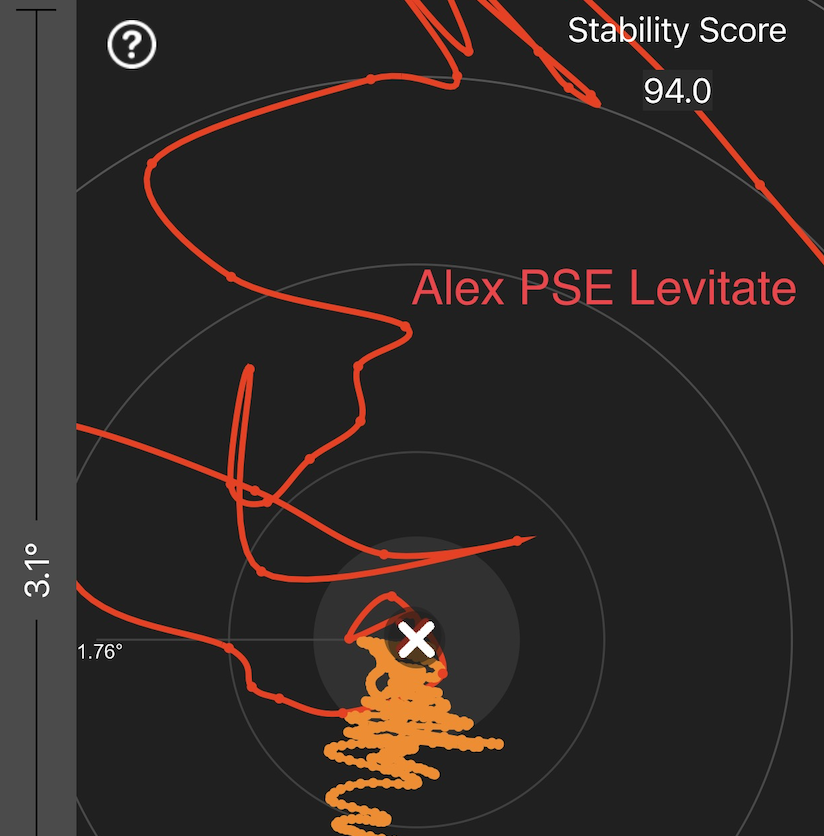
Above, you’ll see Robinson’s Mantis reading. His pin float was extremely tight and predictable (that’s indicated by the orange line wiggling back and forth up to the target). On the release there was almost no bow movement—the two Xs are stacked right on top of each other. He achieved a stability score of 94 with a bow that weighs 4 pounds. That stability score is nipping at the heels of what pro archers achieve with fully rigged target setups.
You can tell the Levitate has high-performance cams while drawing the bow, but the draw cycle isn’t as aggressive as a true speed bow. You have early draw weight, an even middle, and a final hump before the cams smoothly roll over into the 90 percent let-off. The back wall is solid with no noticeable sponginess. The valley is forgiving and even without a stabilizer we achieved a slow and predictable pin float. At the release, the bow jumps to the target. It’s not a teeth-shattering vibration, or anything I’d even describe as vibration. Instead, it’s simply an equal and opposite reaction to the release of an arrow that’s noticeable only because this bow weighs so little.
We tested bows on cold January days in Lancaster, Pennsylvania, but gripping this carbon bow was a pleasure during those temps. The Levitate’s grip is square, ¾ inches wide, and flat with beveled corners. It’s a comfortable grip that’s easy to shoot well.
The Levitate didn’t run away with the Editor’s Choice: It was in a tight race with the Mathews V3X. To push the two bows to their limits, Reilly conducted a forgiveness test to see if the lightweight Levitate could handle bad shots. He pulled hard into the stops and fired; the arrow hit the dot. He creeped forward and fired a shot; the arrow hit the dot. He gave the bow a death grip to induce torque and yes, the arrow still hit the dot. It was really impressive to see a sub-4-pound bow capable of maintaining accuracy under those conditions. The V3X did equally well in the forgiveness test, but the Levitate’s innovative design ultimately separated it from the V3X.
Read Next: Extended PSE Nock On Carbon Levitate Review
The PSE Levitate’s biggest downside is its price. This is an expensive bow at $1,899, or $700 more than the Mathews V3X. Yet, it is comparable in price to other flagship carbon bows. Given its price tag, this won’t be the best bow for everyone. But if you’re dead-set on the best lightweight, tack-driving bow out there, then this is a bow for you.
The Best Shooting Experience: Mathews V3X
Mathews V3X Specs
- Axle-to-axle: 29 inches
- Weight: 4.83 pounds
- Speed: 275.5 fps
- Draw weight: 64.7 pounds
- Draw length: 29 inches
- Holding weight: 12.6 pounds
- Center shot: 13/16 inch
- Nocking point: Level
- Price: $1,099



Mathews V3X Review
If the Levitate left our testers in awe, then the V3X left testers saying, “Damn that’s a nice bow.” The V3X was the nicest-shooting bow we tested, and it was a close second for Editor’s Choice.
The V3 was one of the most popular bows of 2021, and the V3X takes all that you loved about the V3 and adds additional features. You’ll get the same cams, Integrate arrow rest mount, and cable guard on the V3. But the V3X comes in longer axle-to-axle lengths, with the new Bridgelock sight mount and the Stay Afield System.
We tested the V3X with an Axcel Bridgelock sight and QAD Integrate arrow rest, both accessories were so streamlined it seemed like they were built into the bow. The V3X is compatible with a portable bow press, the Stay in the Field System, that’s pretty genius. For years we’ve had to do sketchy things to make in-the-field repairs, like sticking Allen wrenches in cams. But now you can get an OEM portable bow press and change a peep or string right in the field.
Testing the V3X
You’ll notice a theme in the flagship bows: All of them were easy to tune. We didn’t have to shim cams or use a bow press on a single bow. The Mathews V3X wasn’t an exception, it was a first shot bullet hole tuning job.
The draw cycle is what we liked most about the Mathews, which requires consistent effort from the start of the draw to the end. There are no humps to pull past, no dump into the valley. To me, the smooth draw feels 5 pounds lighter than the actual draw weight. I can see this feature coming in handy when you need to slowly draw on a cagey old buck. Both Reilly and Robinson said the V3X was the nicest shooting bow they’ve ever shot. The V3X was tested by Stress Engineering, whose engineers found it to be the quietest bow they tested at 76.7 db. (For perspective the loudest bow they tested, Bear Refine, was 83.5 db.)
While we loved the V3X’s draw cycle, we didn’t like the grip. The V3X grip is plastic and rubber with a rounded shape that makes it comfortable, but easy to torque and hard to consistently position your hand. There is a silver lining. We decided to remove the grip and shoot the bow on the bare riser. Groups tightened by as much as 50 percent without the grip. Aftermarket grips are also available for the Mathews bows from manufacturers like Ultraview.
At 20 yards Reilly’s worst group with the stock grip was 2 inches, but without the grip his worst group was 1.2 inches. We shot 50-yard groups without the grip, during which Robinson averaged 3.5-inch groups and Reilly averaged 2-inch groups with an impressive .75-inch group in the mix. Reilly also conducted the forgiveness test with the V3X (no grip) and it handled each phase without issue. Each arrow hit the dot regardless of torque, creep, or pulling hard into the wall.
Read Next: Extended Mathews V3X Review: “The Nicest Shooting Compound Bow I’ve Ever Tested”
If you like smooth drawing and easy-to-shoot bows, the V3X is worth a test drive. This bow is an absolute joy to shoot in the backyard all summer and from a stand all fall.
The Sleeper: Darton Spectra E
Specs
- Axle-to-axle: 32 inches
- Weight: 5.31 pounds
- Speed: 267.6 fps
- Draw weight: 65.4 pounds
- Draw length: 29 inches
- Holding weight: 11.1 pounds
- Center shot: 13/16 inch
- Nocking point: Level
- Price: $1,050



Spectra E Review
If you love underdogs, then you’ll want to know why Reilly calls the Darton Spectra E the best bow no one is talking about. Darton has been flying under the radar for several years, and now they’ve made one of the best bows we tested.
Any archery fan should learn the name Rex Darlington, Darton’s former owner and current engineer. Because chances are that the bow you currently own (and indeed, every bow we tested this year) contains at least one part that Darlington patented. He knows a thing or two about building bows.
When designing the Spectra E, Darlington had stability in mind. He started with the 7075 T-6511 aluminum riser, which has a high strength-to-weight ratio. The wide limb stance further increases stability and Darton made the limbs parallel to help reduce vibration. The cams have a cable stop and draw stop for a rock-solid wall. The cams also have Darton’s E system which is a new take on yolks. With three points of contact instead of two, the E system evens out pressure on the axles and contributes to accuracy.
Testing the Spectra E
When the first shot from the Spectra E went through paper it was obvious we had an issue. There was a huge vertical tear. It turned out we were just getting contact off the rest. We adjusted the arrow rest timing and got a bullet hole.
The first thing you’ll notice when you shoot a Spectra E is its mass weight. This is a hefty compound. But at full draw, the weight wasn’t noticeable. Robinson recorded his best 50-yard groups with the Spectra-E, with an overall 2.5-inch average. Reilly’s 50-yard average was even tighter at 2.1 inches. At 20 yards, Reilly shot a ridiculous .3-inch group while Robinson averaged a .6-inch group. Those group sizes make it the most accurate bow we tested. Robinson noted the bow seemed to hold itself on target, and Reilly said the bow felt stable at full draw.
Those groups were sweet, and so was our shooting experience with the Spectra E. As you start the draw and overcome the early draw weight, you’ll transition to a nice, even pull and then a slight dip into the valley. Thanks to that very generous valley, you can hold this bow at full draw for days. The double-draw stops make for a solid, defined back wall that you’ll have a hard time creeping from. The beefy riser helps tamp down any vibration so the bow sits still on the shot.
Read Next: Extended Darton Spectra E Review: The Most Underrated Flagship Bow
If you don’t care about the hottest brand names or Darton’s retro graphics (like the flame designs on the grip) and you just want a bow that’s capable of superb accuracy, give the Darton Spectra E a try.
Best Long-Draw Bow: Hoyt Highline
Specs
- Axle-to-axle: 35 inches
- Weight: 6.2 pounds
- Speed: 262 fps (500-grain arrow)
- Draw weight: 63 pounds
- Draw length: 32.5 inches
- Holding weight: 7.5 pounds
- Center shot: 13/16 inch
- Nocking point: ⅛ inch high
- Price: $1,399



Hoyt Highline Review
Everyone thinks being tall is great, but there are downsides: You can’t find clothes that fit, you hit your head all the time, and all the cool bows don’t come in your draw length (mine’s 32.5 inches). Sure, I can shoot a 500-grain arrow at good speeds without pulling 70 pounds, but I’m telling you: It’s not easy being 6 feet 6 inches tall. I’ve shot some really bad long-draw bows with rough draw cycles and a mean thump on the shot. Those were bows that went to my draw length, yes, but they weren’t engineered to be pleasant to shoot at my draw length.
I’m done griping though, because Hoyt came through for us tall archers with the Highline. It adjusts from 29 to 34 inches of draw length with a rotating mod.
Testing the Hoyt Highline
This bow also proved easy to tune, and I settled on a ⅛-inch high nocking point and 13/16-inch center shot. (I can’t emphasize enough how relieved I am that the Highline and the other bows in this test were easy to tune. There’s nothing worse than getting a hard left tear that takes an hour to tune out.)
The Highline is everything you’d want in a hunting bow: smooth, accurate, and well-behaved. I also think that the 35-inch axle-to-axle is a good compromise between an agile hunting bow and a comfortable string angle. It’s easy to get the cams moving and the pull is very even after the first few inches of draw. It has a forgiving valley and solid wall. I’m used to long draw bows with a kick on release, but this bow just sits after the shot.
I felt comfortable and stable at full draw. My arrows hit behind the pin, and I averaged 2.6-inch groups at 50 yards. The pin float was slow and predictable, so I look forward to spending time getting a stabilizer setup dialed for the Highline. This bow has two cons: I expected it to be faster, and it’s pricey.
Bear Refine EKO
Bear Refine EKO Specs
- Axle-to-axle: 33 inches
- Weight: 4.94 pounds
- Speed: 278 fps
- Draw weight: 65.2 pounds
- Draw length: 29 inches
- Holding weight: 9 pounds
- Center shot: 13/16 inch
- Nocking point: ⅛ inch high.
- Price: $1,000



Refine EKO Review
Bear Archery is known for building a bow for everyone. From youth to flagship bows, Bear has a bow that will fit any archer, and any budget. The Refine EKO is Bear’s flagship offering for 2022, and it has some cool features. There’s a level built into the bow that’s meant to help archers level their sights. The bow also has a 15-pound draw-weight adjustment range compared to the typical 10-pound range. The let-off is also adjustable from 75 to 90 percent. But as useful as those features are, the Refine EKO isn’t quite on par with other top flagships in our test.
Testing the Bear Refine EKO
The Refine EKO shot a bullet hole on the first shot. It’s worth noting that the Refine liked an ⅛ -inch high nocking point.
When you look at the Refine EKO’s round cams, you can probably guess it’s going to be smooth, and it is. It’s a linear draw with no humps to overcome. The valley isn’t deep, but it doesn’t feel like the string wants to jump forward, either. On the shot there’s some noticeable vibration. Stress Engineering tested the Refine EKO and it had the most vibration of the bows tested, at 28.2 m/s2. For comparison, the Elite EnVisio had the least vibration at 11.8 m/s2, and even the second-to-last bow in the vibration ranking was still just 17.6 m/s2.

Reilly and Robinson had a hard time holding steady with the Refine EKO. Above you’ll see Mantis data from Robinson’s 50-yard test. The float ranges from 1 to 1.5 degrees and it’s not a consistent holding pattern. This difficulty in getting steady translated to Robinson’s groups, which averaged 5.7 inches. Despite not being able to hold steady, Reilly shot a solid 2.4-inch average. It’s also worth noting that Robinson shot a respectable 1.2-inch-group average at 20 yards with the Refine EKO. I suspect some of the accuracy inconsistency has to do with the rounded plastic grip, which makes it difficult to apply consistent grip pressure.
Bear has some work to do for the Refine EKO to compete with similarly priced offerings like the V3X and Spectra E. I’d suggest changing the grip to a flat, square configuration and widening the limb stance.
Bowtech SR350
Bowtech SR350 Specs
- Axle-to-axle: 33 inches
- Weight: 5.03 pounds
- Speed: 288 fps
- Draw weight: 67 pounds
- Draw length: 29 inches
- Holding weight: 17 pounds
- Center shot: 13/16 inch
- Nocking point: Level
- Price: $1,299


Bowtech SR350 Review
In my experience, chasing speed isn’t a good idea, but the nice thing about the SR350 is that you have the option of swapping between Performance and Comfort settings. If you want your arrows to hit the target before everyone else’s, use the Performance setting. If you prioritize smoothness and shooting experience, use the Comfort setting.
The SR350 looks similar to the 2021 Solution, but its cams are quite different. The SR350 sports a teardrop shaped cam, which helps generate faster speeds than the Solution’s rounder cams. Bowtech has one of the best tuning solutions built into their bows: the Deadlock. That tuning system allows you to easily move cams left and right without a bow press, e-clips that fly into outer space, or lost shims. Moving the cams is just as easy as it is to adjust the draw weight.
Testing the SR350
Tuning the SR350 was relatively easy: The first shot produced a high tear, but moving the arrow rest down resulted in a clean bullet hole on the second shot.
I would describe shooting the SR350 like shooting a lightweight .300 Win Mag—it’s not something you’d want to shoot all day. It takes a lot of effort to roll the cams, the middle is smooth, and there’s a final hump to pull through before you enter the narrow valley. Once you reach full draw, the work isn’t over: you need to be on your game to keep the bow there. This discomfort affected accuracy for both shooters. Reilly’s accuracy was feast or famine at 50 yards, with his smallest group at 1.5 inches and his largest at 6.25 inches. Robinson averaged 5.1 inches at 50 yards.
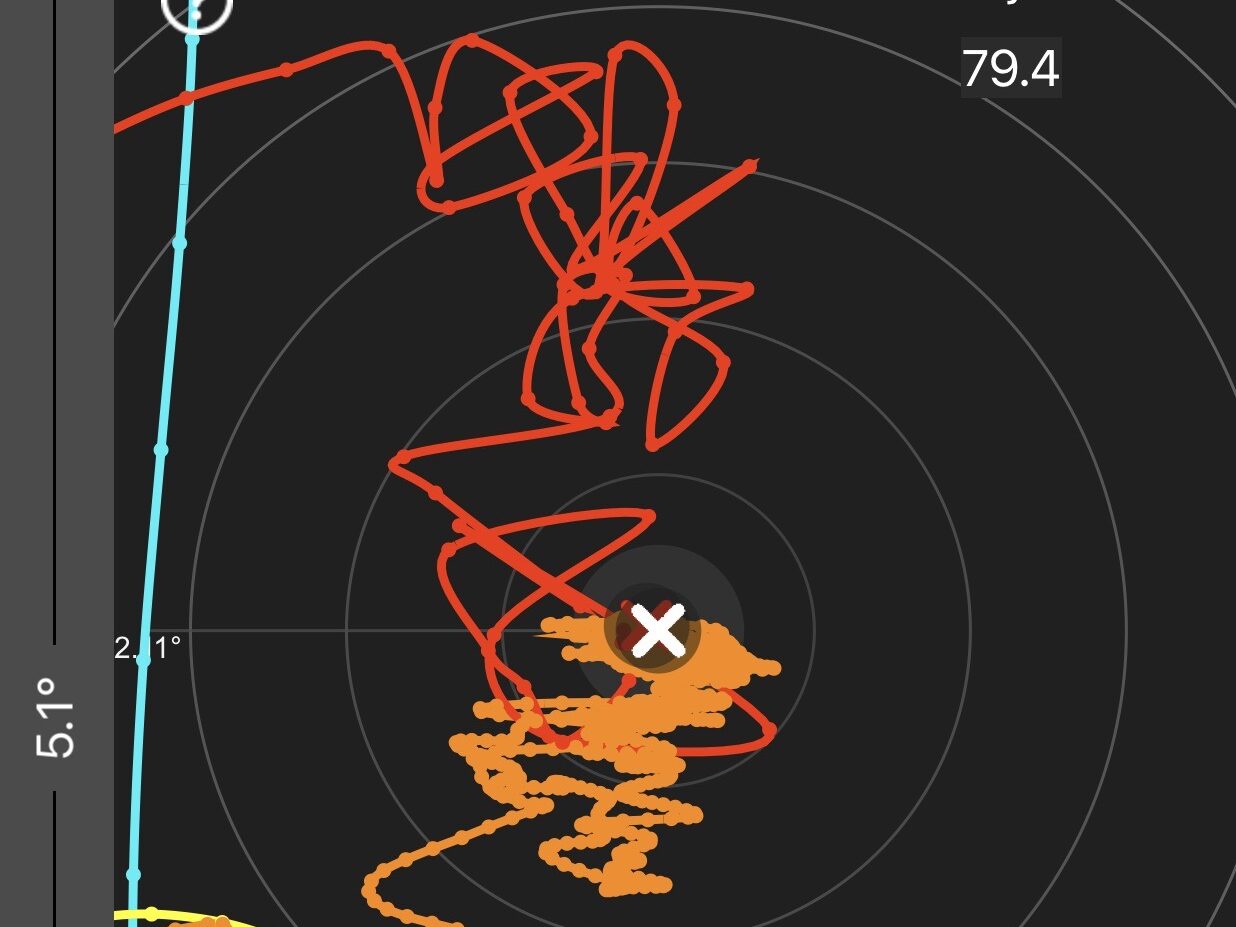
Above you’ll see Robinson’s Mantis data from the SR350. You’ll notice wide left to right movement, which was likely caused by muscle tension. You can also see the bow was very stable after the shot. So, if an archer dedicated the time to mastering this bow, there’s little doubt that it’s capable of tight groups.
“If I were to hunt with this bow, I’d have to drop to the 60-pound model or shoot it on the Comfort setting, or both,” Robinson says. “For reference, I hunted comfortably with a 70-pound Bowtech Experience this fall.”
Some of the best archers in the world prefer aggressive cams because they feel they’re more accurate. So, if you decide to shoot the SR350 on the Performance setting, I’d recommend working with a coach to dial in your draw length and get yourself in perfect alignment. Using steady back tension by pulling your elbow back and around your head will also keep the bow on its stops.
Read Next: Extended Bowtech SR350 Review: A Versatile and Customizable Hunting Bow
For those who don’t want to use the Performance setting, the good news is according to Reilly’s review on the SR350 you’ll only lose 10 fps by going to the Comfort setting. And you’ll gain a lot of comfort. If you’re test driving the SR350, I’d recommend starting on Comfort and, if you’re looking for more speed, then try Performance.
Elite EnVision
Elite EnVision Specs
- Axle-to-axle: 31 inches
- Weight: 4.92 pounds
- Speed: 263 fps
- Draw weight: 64.6 pounds
- Draw length: 29 inches
- Holding weight: 13 pounds
- Center shot: 13/16 inch
- Nocking point: Level
- Price: $1,200


Elite EnVision Review
Designing a bow is often a compromise between speed and comfort. If you want a fast bow, it’s not going to be fun to draw or hold. Meanwhile, bows that are easy to draw are usually slow. Elite has made its reputation on building smooth and shootable bows—not speed bows. And that’s exactly what you’ll get in the EnVision.
Testing the EnVision
A few of the bows preferred a slightly high nocking point, but the EnVision shot a perfect bullet hole when set to dead level and a 13/16-inch center shot. If more tuning is necessary, Elite’s S.E.T. technology makes bare-shaft tuning easy, and you don’t need a bow press to make adjustments. Another benefit for home bow mechanics is that you don’t need to mess with strings and cables to dial in your draw length at ¼ inch increments. If your draw length is 28.25 inches you don’t have to compromise at 28 or 28.5 inches. You can set it to your exact draw with the rotating modules.
The EnVision’s draw starts off smooth, transitions into an even smoother pull, and then finishes smooth. There are no humps or variations in effort throughout the draw cycle. Testers commented that the bow felt lighter than the measured draw weight, and Robinson said it was by far the easiest bow to draw. Like most Elites, there’s a generous valley and you have to almost push the bow forward to let it down. On release there’s no handshock. At 11.8 m/s2, it had the least vibration of all the bows Stress tested.
I really like the grip on the EnVision, and the other testers gave it top marks. It’s easy to consistently place your hand in the exact same position for each shot. The grip and the bow’s stability helped us achieve excellent accuracy. Robinson shot this bow at the end of the day after running the gauntlet of bows, but still managed to average 3.5 inches at 50 yards. Reilly averaged 2.3 inches at 50 yards with the EnVision.
Read Next: Full Elite EnVision Review: Customizable and Accurate
The Elite EnVision is a sweet-shooting bow that you can hold at full draw all day while waiting for the perfect shot opportunity. If you’re not a speed freak, this one is definitely worth a test drive.
Hoyt RX-7
Hoyt RX-7 Specs
- Axle-to-axle: 30 inches
- Weight: 4.72 pounds (with short stop stabilizer)
- Speed: 274.5
- Draw weight: 65.7 pounds
- Draw length: 29 inches
- Holding weight: 11 pounds
- Center shot: 13/16 inch
- Nocking point: ⅛-inch high
- Price: $1,749



Hoyt RX-7 Review
Hoyt carbon bows haven’t always been much lighter than their aluminum counterparts. But for 2022 Hoyt redesigned its carbon riser, and the results are phenomenal.
The headline feature is Hoyt’s first 100 percent carbon riser (previous models had aluminum caps). The riser is also stiffer and lighter than previous generations. For perspective, the Carbon RX-7 is about .5 pounds lighter than the Ventum 33, and .3 pounds lighter than the 2021 Carbon RX-5. If you missed the news last year, Hoyt jumped on the binary cam train and hasn’t looked back. The new HBX cam is lighter and addresses sight alignment issues some archers experienced with the 2021 models. The RX-7 also has a Picatinny sight mount on the front of the riser and a dovetail arrow rest, and it’s compatible with low-profile quivers for a slim hunting setup.
Testing the RX-7
The RX-7 was another one-shot bullet hole when it came to tuning. It liked the standard 13/16-inch center shot, even cam timing, and level nocking point.
There was a departure between the two primary testers on the RX-7. Reilly found the cams to be smooth and easy to hold at full draw with a deep valley. Robinson felt the draw was stout, but smoothed out at the end. To me, the cams take effort to start moving. But once they start, they’re butter. There’s a nice transition to the valley with no dump into the let-off. At full draw, there’s no jumpiness and I found the valley generous. Once the arrow is gone you’ll experience no handshock or jump. Stress Engineering confirmed this with its data. The RX-7 had the second shortest vibration (13 m/s²) of the seven flagship bows they tested. To my ears it was also very quiet.
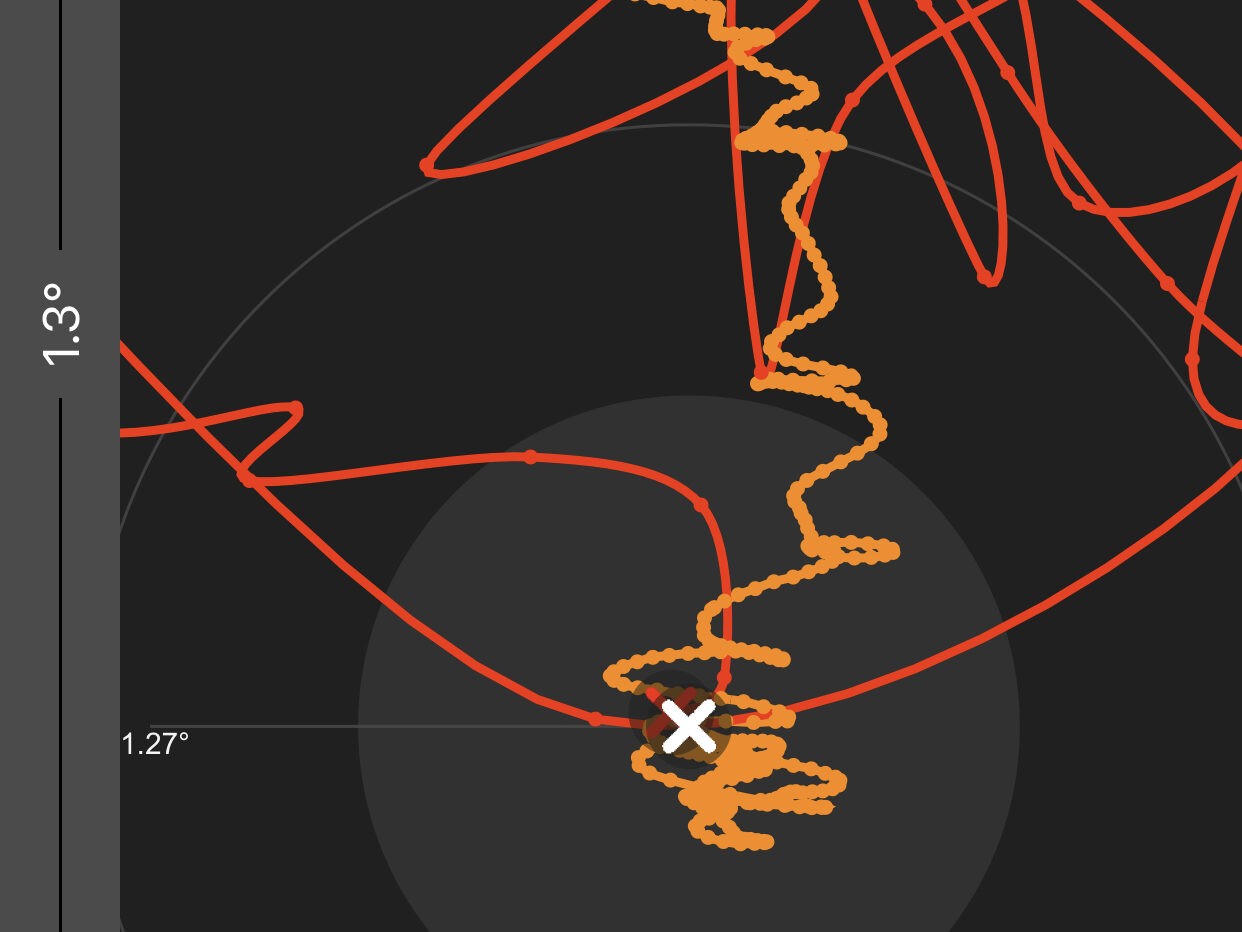
Reilly currently hunts with a Mathews, but I think he should shoot a Hoyt based on his accuracy and Mantis results. Above, you’ll see Reilly’s Mantis reading on the RX-7. Pay close attention to the orange line and the distance between the two Xs. You’ll see a very tight hold pattern and very little movement on release. His groups reflected that steady aim with his best 50-yard group average of 1.6 inches. Robinson wasn’t as comfortable with the bow and shot a 3-inch average at 50 yards. He noted that it took more effort to shoot well compared to other bows he tested.
Read Next: Extended Hoyt RX-7 Review: A New Riser and Cam Design for Hoyt’s 2022 Carbon Flagship
This is a great example of why it’s so important to find the right bow for you: a bow that one person shoots lights-out, another person might not prefer.
Hoyt Ventum Pro 33
Specs
- Axle-to-axle: 33 inches
- Weight: 5.23 pounds (with short stop stabilizer)
- Speed: 282 fps
- Draw weight: 66.3 pounds
- Draw length: 29 inches
- Holding weight: 14.4 pounds
- Center shot: 3/4 inch
- Nocking point: 1/16 inch high
- Price: $1,349


Hoyt Ventum Pro 33 Review
This year’s hype is all about Hoyt’s Carbon RX-7, but Hoyt knows how to make a killer aluminum bow, too. The Ventum was a great bow and the company has taken that platform and made a few welcome upgrades.
The Ventum Pro 33 has the lighter HBX Pro cams, which have been shifted for a better sight picture and vane clearance. There’s a Picatinny rail machined into the riser for attaching Pic-mounted sights. There’s also the Integrate arrow rest mount and the bow is compatible with low-profile quivers (low-profile setups are a trend with many of the flagship bows this year). Hoyt reduced the grip angle by 4 degrees for a lower wrist and, in my opinion, a more comfortable grip.
Testing the Ventum Pro 33
The first shot through the Ventum Pro 33 produced a 1-inch left tear. We adjusted the rest slightly and got a bullet hole on the second shot. You’ll notice that the final center shot ended up being ¾-inch, which is measured from the inside of the riser to the center of the arrow shaft.
The draw cycle is a lot like the RX-7: There’s initial effort to get the cams moving and then it’s a smooth pull straight to the wall. The bow is well behaved after the shot, too.
At 50 yards, Reilly averaged 2.4-inch groups while Robinson had a 3.2-inch average. Both reported that the Ventum Pro 33 held nicely, the shots broke clean, and it had a firm back wall. All the testers agreed that the RX-7 was the better-shooting Hoyt in the test, but that the Ventum Pro is a solid option for Hoyt fans who like aluminum bows. At 282 fps the Ventum Pro was also one of the faster bows we tested, although it didn’t feel like a speed bow. If you want an even faster Hoyt, the RX-7 Twin Turbo is worth a look.
Prime Inline 3
Prime Inline 3 Specs
- Axle-to-axle: 33 inches
- Weight: 4.92 pounds
- Speed: 268 fps
- Draw weight: 65.6 pounds
- Draw length: 29 inches
- Holding Weight: 10.6 pounds
- Center shot: 13/16 inch
- Nocking point: ⅛ inch high
- Price: $1,099


Prime Inline 3 Review
The Inline series of bows is a departure from Prime’s signature parallel cams. With the Inline, Prime simplified and improved their design while retaining the benefits of a parallel cam. The result is a lighter, quieter bow that’s easy to tune.
Testing the Prime Inline
If you’ve made it this far in the review it shouldn’t surprise you that this was another easy-to-tune bow. I was hoping we could test Prime’s new shim tuning system, but it wasn’t necessary to achieve a bullet hole. For home bow mechanics, you won’t be able to shim your cams because the tool required is only available to dealers. That could be a deal breaker if you like to work on your own bows and you live far from a shop.
The Prime has a draw cycle that is mostly smooth but with two points that require additional effort: the beginning and just before the valley. The humps are subtle but still noticeable. At full draw you’re locked into a good valley with a solid back wall thanks to the limb stop. Stress measured the Inline’s vibration at 17.6 m/s2 , which was toward the bottom of the pack. For perspective, the EnVision had a vibration measurement of 11.8 m/s2.
At 20 yards Reilly and Robinson shot good groups with a cumulative average of 1.25 inches. But both archers’ groups opened up at 50 yards. Reilly averaged 4.5 inches and Robinson averaged 3.6 inches, which were some of their largest groups in the tests. Both archers said it felt like they were breaking good shots, but the arrows weren’t hitting behind the pin.
Read Next: Extended Prime Inline Review: A New Look for Prime Archery
It’s exciting to see bow manufacturers like Prime willing to make drastic design changes to improve their bows. Even with the less-than-stellar accuracy results, the Prime Inline is better than previous generations and an exciting new direction for the company.
PSE EVO XF
PSE EVO XF Specs
- Axle-to-axle: 33 inches
- Weight: 4.85 pounds
- Speed: 282 fps
- Draw weight: 65.6 pounds
- Draw length: 29 inches
- Holding weight: 13.6 pounds
- Center shot: ¾ inch
- Nocking point: 3/16 inch high


PSE EVO XF Review
PSE Launched its new flagship aluminum bows at the 2022 ATA Show by rolling out the Evo XF and the Evo XF 33. The cool thing about these bows is that between the two of them, they’ll fit archers with draw lengths from 25 to 32.5 inches. It’s great to see PSE didn’t forget short-draw and long-draw archers in these flagship offerings.
Testing the EVO XF
While we started each bow with a level nocking point, we had a few bows that preferred a slightly high nock. The EVO XF was one of these. Our first shot through paper resulted in a low tear. We moved the rest down a little and got a bullet hole. The center shot ended up being right between ¾ and 13/16 inch. If you started with either, you’d be in a good position to begin tuning.
When you draw the EVO XF, you can tell it’s going to produce fast speeds. There’s considerable early draw weight, an even middle of the draw, and a final hump before the valley. The valley is forgiving and there’s a solid back wall. The release is pleasant and the vibration minimal.
Both testers noted the bulky grip, although Reilly says it didn’t seem to matter because his arrows hit behind the pin and the bow held solid. He shot a 1.1-inch average at 20 yards. Robinson also felt the bow held steady, but thought his 3.42-inch average at 50 yards was lacking.
The EVO XF is a fast and accurate hunting bow, with a grip and draw cycle not all archers will like.
Xpedition Smoke
Xpedition Smoke Specs
- Axle-to-axle: 32 inches
- Weight: 5.18 pounds
- Speed: 282 fps
- Draw weight: 62.6 pounds
- Draw length: 29 inches
- Holding weight: 15.8 pounds
- Center shot: 3/4 inch
- Nocking point: 3/16
- Price: $1,099


Xpedition Smoke Review
Xpedition has made some awesome shooting bows in the past and the company continues to crank out great designs. The Smoke is its fastest bow ever, and it’s the best shooting speed bow we tested. It uses Xpedition’s hybrid cam design to generate that speed while maintaining a relatively smooth draw. Other features that we liked are the machined grip, durable finish, and a rear stabilizer bushing that sits very low, which will help your bow settle faster.
Testing the Smoke
Our first shot produced a slight lateral tear. After a small arrow rest adjustment, we shot a bullet hole on the second.
It doesn’t take much to start the draw and you’ll use even effort as you pull straight to the valley. During the five-foot test, I checked the valley to see what would happen if I relaxed just a little at full draw and quickly collapsed. The back wall is rock solid thanks to the limb stops, but the narrow valley is just one of the tradeoffs for the Smoke’s speed. It had the third-least vibration (16 m/s2) of the bows tested at Stress Engineering.Just like the SR350 on performance, you’ll want to make sure your draw length and alignment are dialed so you can shoot this bow well. Keep in mind that steady tension and direction will keep the stops against the limbs.
We achieved average accuracy with the Smoke. Reilly shot 2.75-inch average groups at 50 yards, and Robinson had a 3.33-inch average. Both archers averaged 1-inch groups at 20 yards. Reilly noted that the comfortable and solid back wall seemed to help him hold steady. We did have an unexplained issue when a cable came out of the roller guard during accuracy testing. Luckily we were at Lancaster Archery Supply, and their pros were able to quickly reserve the cable and get the bow back shooting.
If you like speed bows, the Xpedition Smoke should be on your shortlist to try out, especially if you’d prefer to support a smaller manufacturer.
Final Thoughts
We learned a lot from shooting all these bows back-to-back and noticed trends in compound bow design. Bows aren’t getting any faster, but they are more pleasant to shoot and easier to tune. We’re seeing more bows equipped with tuning features like the Elite’s S.E.T., Bowtech’s DeadLock, and Mathews’ Stay in the Field system. Long risers and short parallel limbs are the go-to design for hunting bows. The three-track binary cam is also something we’re seeing in many of the top bows. More manufacturers are adopting low-profile rests, sights, and quivers. I wouldn’t be surprised if a dovetail arrow rest mount becomes the standard in a few years. Another interesting trend is that many manufacturers are putting more thought into rear bar stabilizer bushings on hunting bows.
There really aren’t any bad bows on this list—especially if you consider that our largest groups at 50 yards were around 6 inches, and none of the bows were difficult to tune. If you’re buying a new compound bow in 2023, you’re able to choose the bow that best fits your shooting style without making major compromises. Use our review to narrow your choices and then have fun testing the bows yourself at your closest dealer.
